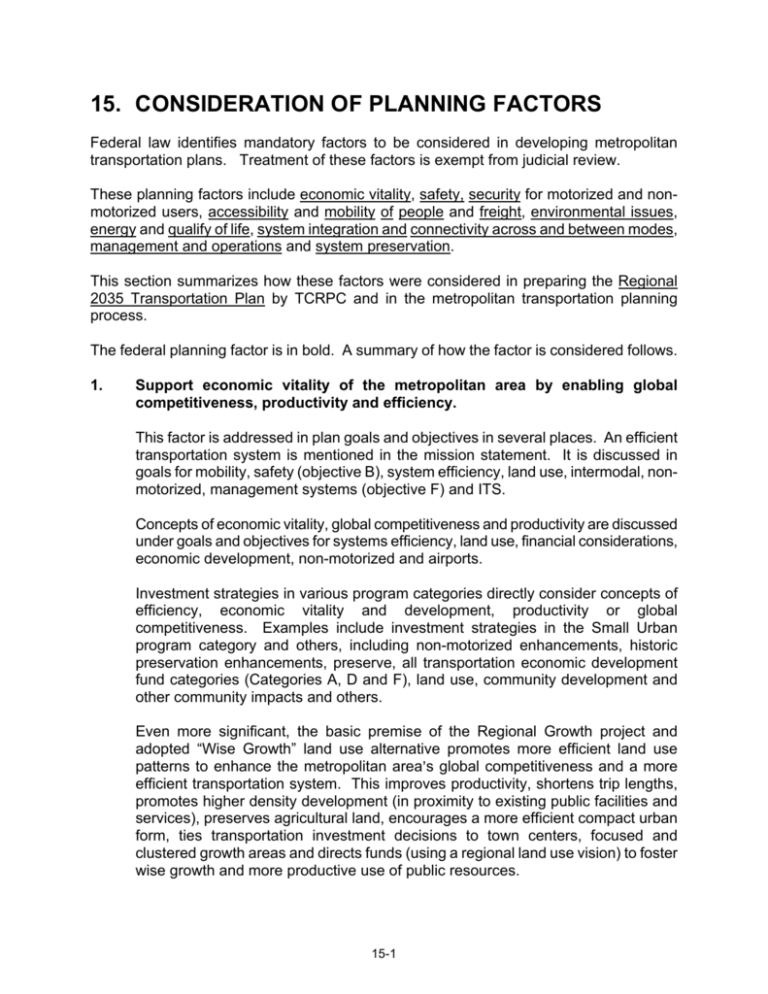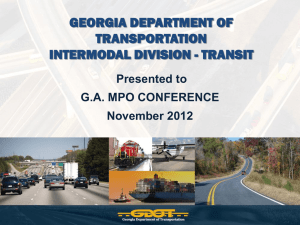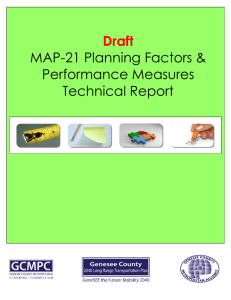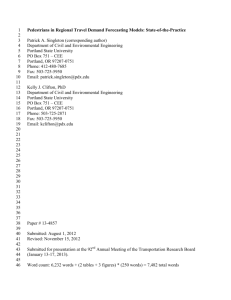Chapter 15 - Consideration of Planning Factors - Tri
advertisement

15. CONSIDERATION OF PLANNING FACTORS Federal law identifies mandatory factors to be considered in developing metropolitan transportation plans. Treatment of these factors is exempt from judicial review. These planning factors include economic vitality, safety, security for motorized and nonmotorized users, accessibility and mobility of people and freight, environmental issues, energy and qualify of life, system integration and connectivity across and between modes, management and operations and system preservation. This section summarizes how these factors were considered in preparing the Regional 2035 Transportation Plan by TCRPC and in the metropolitan transportation planning process. The federal planning factor is in bold. A summary of how the factor is considered follows. 1. Support economic vitality of the metropolitan area by enabling global competitiveness, productivity and efficiency. This factor is addressed in plan goals and objectives in several places. An efficient transportation system is mentioned in the mission statement. It is discussed in goals for mobility, safety (objective B), system efficiency, land use, intermodal, nonmotorized, management systems (objective F) and ITS. Concepts of economic vitality, global competitiveness and productivity are discussed under goals and objectives for systems efficiency, land use, financial considerations, economic development, non-motorized and airports. Investment strategies in various program categories directly consider concepts of efficiency, economic vitality and development, productivity or global competitiveness. Examples include investment strategies in the Small Urban program category and others, including non-motorized enhancements, historic preservation enhancements, preserve, all transportation economic development fund categories (Categories A, D and F), land use, community development and other community impacts and others. Even more significant, the basic premise of the Regional Growth project and adopted “Wise Growth” land use alternative promotes more efficient land use patterns to enhance the metropolitan area=s global competitiveness and a more efficient transportation system. This improves productivity, shortens trip lengths, promotes higher density development (in proximity to existing public facilities and services), preserves agricultural land, encourages a more efficient compact urban form, ties transportation investment decisions to town centers, focused and clustered growth areas and directs funds (using a regional land use vision) to foster wise growth and more productive use of public resources. 15-1 In this context, this plan considers this factor through the Regional Growth project, the adopted regional growth scenario, demographics, network alternatives analysis and so forth. Similarly, consideration was given in deficiency analysis for economic development/access, intermodal planning issues and other elements. 2. Increase safety of the transportation system for motorized and non-motorized users. Safety is addressed in the mission statement. Numerous specific goals or objectives also speak to safety. Examples include objective D under the accessibility goal, a specific safety goal/objectives, system efficiency (objective M), transit goal (objective F), intermodal, non-motorized, management systems (objective B) and objective A under the Intelligent Transportation System goal. Safety is directly considered in investment strategies for various program categories. Specific safety and safe routes to schools program categories provide safety investment strategies. Other example investment strategies are in the following program categories: Small urban; Non-motorized enhancements; Aesthetic enhancements; Improve-expand; Bridge; Preserve; Land Use, community development and other community impacts; and Management and operations. Many other goals, objectives and investment strategies indirectly reflect consideration of safety, although not the word “safety.” Examples include activities like access management, passing relief lanes, provision of sidewalks, non-motorized components in project design, traffic calming measures, management and operations and similar concepts. Each of these examples specifically reduce crashes (such as access management or traffic calming) or improve safety for nonmotorized users (sidewalks, non-motorized facilities, etc.). Criteria and performance measures in this plan and used in setting project priorities also include specific measures (such as crash rate analysis) in the project selection process. Safety for motorized and non-motorized users is considered in the regional land use vision by integrating concepts like access management, traffic calming, mixed use/clustered development and similar concepts in the AWise Growth@ scenario. These land use strategies directly reduce crashes or improve walkability/bikeability of town centers, focused and clustered growth areas. 15-2 Safety is considered directly in plan chapters or sections on statewide plan coordination, management systems, deficiency analysis and the non-motorized and public transit elements. This short summary has not differentiated between motorized and non-motorized users in every case, but examples demonstrate consideration given to both and to all categories of users. 3. Consider Security Consideration has been given to security in plan development. Most of this consideration has been indirect. Prior to terrorist attacks of September 11, security in the factors had a different meaning than since September 11. Prior to September 11, this term could reflect considerations such as security of transit patrons at bus stops, security during bus transit trips or lighted non-motorized pathways to contribute to user’s feelings of security. Consideration was given to this type of security in various sections: ITS, transit, management systems, management and operations, traffic calming, various bicycle and pedestrian investment strategies, criteria for transit enhancements, the accessibility objective concerning the Americans with Disabilities Act (ADA), land use goals and objectives and so forth, although the term Asecurity@ was not used specifically. However, Asecurity@ was specifically included in Chapter 4 and in the safety goal of the State Long Range Plan, incorporated in this plan and which considered the context of Asecurity@ before and after September 11. Security is also a mandatory one percent capital set aside under the Section 5307 Transit Capital program and included in the transit capital budget for CATA. The Regional ITS Architecture document, incorporated in this plan by reference and summarized in Chapter 13, also specifically provides for suitable interconnects between transportation operations, emergency responders, transit and traffic control centers and provides for substantial interoperability of transportation communications which facilitates security response. An emergency vehicle signal pre-emption project underway using federal high priority project funds, improves response time in cases of security or other emergencies. TCRPC also completed FEMA hazard mitigation plans for each of the region’s three counties. While more focused on security from natural hazards, these plans were formulated using the adopted “Wise Growth” scenario as a land use base, which promotes compact development and environmental preservation, which also benefits security by encouraging growth where higher concentrations of security providers and first responders are usually available to provide increased security at higher levels of service. Staff preparing hazard mitigation plans coordinated with staff preparing this transportation plan, to facilitate additional linkages between the two planning efforts as appropriate. Another example of security planning efforts includes staff mapping and technical assistance to area first responders in preparing for incidents on the region’s non- 15-3 motorized pathways, as well as identifying access ways to improve response time on pathways or other off-road facilities. MPO agencies, including each of the three transit agencies and others, also assist in developing area response plans and are directly involved in implementing these plans under certain emergency conditions. Recent analysis in the public media have also reported that many strategic analysts directly view global climate change as a major threat to national security requiring significant advance planning and consideration, including adaptation planning for public infrastructure. These types of considerations are inherent in the regional growth project, plan goals and objectives related to climate change in Chapter 3 and elsewhere throughout this document Although this Regional 2035 Transportation Plan does not provide a comprehensive analysis of transportation security from terrorism, this consideration is discussed in airports, public transit and intermodal facilities and other sections as appropriate. As the nation, transportation professionals and the planning process continue to respond to new challenges posed by September 11 and threats of terrorist attack on transportation, attention to and consideration of, this issue in the metropolitan planning process will also increase. Additional guidance from the U.S. Departments of Transportation, Homeland Security and the Transportation Security Administration may be needed to help focus consideration of security in future plans. 4. Increase accessibility and mobility options available to people and for freight. Transportation must provide accessibility and mobility for people of all socioeconomic classes and allow access and mobility for freight to fuel the economy for people to live or work. This factor is prominently reflected in the first two goals (and related objectives) and in several other goals and objectives (like objective H under land use). The Tri-County travel demand model identifies deficient roadway corridors with mobility or access constraints. Congested corridors are evaluated quantitatively throughout this plan. Deficient or near deficient roads are shown in Chapter 10 and projects identified by road agencies to fix deficiencies are also shown. The Congestion Management process permits quantitative evaluation and contains performance measures to identify congested corridors that may limit accessibility or mobility. Plan goals and objectives refer to the guidebook Evaluating Traffic Impact Studies A Recommended Practice for Michigan Communities which describes procedures to follow in local and inter-governmental development reviews to mitigate traffic impacts. These pre-emptive measures should be considered for implementation in congested corridors. 15-4 Freight movement is considered in goals and objectives and discussed in the Chapter 10 section on intermodal issues. Example goals/objectives include economic development, intermodal and system efficiency goals. Chapter 10 also notes a survey of intermodal facilities/businesses and freight haulers TCRPC used to directly identify freight mobility and access issues. Developing policies to assist or enhance freight movements are recommended for future plan implementation activities. Further study by the MPO and local governments may also be appropriate. TCRPC developed a truck/commercial vehicle submodel to further assist in considering this factor. Some preliminary results from that model are in Chapter 10. Investment strategies in various program categories (Chapter 13) also specifically consider accessibility and mobility of people and freight. Examples include: small urban, various Transportation Economic Development Fund categories to create a network of all season routes, non-motorized, transit, airports, management and operations and ITS program categories. Implementing the adopted AWise Growth@ land use alternative implicitly improves mobility and access for people, freight or goods movement. A compact urban form concentrates new development in proximity to town centers or focused and clustered growth areas. This inherently improves accessibility by reducing trip lengths or mobility by concentrating individuals and employment adjacent to transit and other options making more mode choices available to more people, which improves mobility options. The adopted transportation network alternative (Chapter 11) improves mobility and accessibility by implementing medium transit service level expansions, reducing demand/improving management and operations, along with numerous traditional highway projects. In sum, TCRPC=s planning process considers mobility and access for people and freight throughout plan preparation. 5. Protect and enhance the environment, promote energy, conservation and improve quality of life. This factor is in the mission statement. Goals and objectives related to mobility options, system efficiency, climate change and energy sustainability, environmental impacts, land use, financial considerations (objective K), transit, parking, community impact, non-motorized, management systems and ITS all consider this factor. Investment strategies and program categories consider this factor where appropriate. Examples include: Non-motorized enhancements; Wildlife mitigation enhancements; Drainage enhancements; Improve/expand; 15-5 Bridge; Preserve; Transit capital; Land use, community development and other community impacts; Safety; Congestion Management Air Quality; and Parking. Most significantly, major premises of the ARegional Growth: Choices for Our Future@ project were to reduce environmental impacts, conserve energy and maintain quality of life for the region=s residents and visitors. The adopted AWise Growth@ alternative selected to tie this Regional 2035 Transportation Plan to a regional land use vision inherently considers these factors, as discussed in Chapter 2. The city-centered, environmentally friendly, compact urban form raises density, reduces trip lengths, preserves environmentally sensitive or agricultural lands/watersheds and enhances energy conservation while substantially reducing emissions and maintaining or improving the region=s air quality and quality of life. By supporting alternative modes, improved operations and management and trip reductions, the transportation network alternative adopted by this plan also inherently considers these factors. So do elements which support alternative modes, preserve community character, promote context sensitive design or improve walkability and bikeability. These factors are also directly considered in criteria and performance measures used to select projects and monitor system performance. Further consideration is demonstrated in the environmental justice analysis. Demographic models used to generate inputs to the travel forecasting model include these considerations directly, both in adopted trend forecasts and reallocation of these forecasts in the adopted AWise Growth@ scenario. These models directly consider soils, slopes, wetlands and water features, zoning, accessibility and other environmentally sensitive lands in the region=s future growth forecasts from local plans and zoning ordinances, analysis of Adevelopable@ and Aundevelopable@ lands in each traffic zone or through the local review process. In short, by connecting future transportation investment decisions in this plan to the adopted regional land use vision of AWise Growth,@ considering environmental protection, enhancement, energy conservation and improved quality of life for the region=s residents is literally the foundation of the Regional 2035 Transportation Plan. 6. Enhance integration and connectivity of the transportation system across and between modes for people and freight. System connectivity and integration between modes for people and freight is in plan goals and objectives for mobility, safety, system efficiency, land use, economic 15-6 development, transit, intermodal, non-motorized, management systems and airport issues. It is further considered in statewide plan goals. The plan further considers system connectivity and integration in the deficiency analysis (Chapter 10), whether for highways, non-motorized users, freight/intermodal issues for public transit. Program categories for non-motorized enhancements, small urban, Transportation Economic Development Fund (categories A, D, F), improve-expand, management and operations, intermodal, transit and airports all include criteria and/or investment strategies related to system connectivity, integration and/or freight. While some sections contain direct references to connectivity, others may be indirect. Indirect considerations might be references to developing a system of all season routes (see, for example, the small urban or Category D programs). A primary purpose of an all season route system is to develop integrated and connected routes for freight, commerce and other users which are built to all season standards and not subject to seasonal restrictions or bridge weight limitations. Hence, while Afreight@ or Aintegration@ or “connectivity” may not appear directly, these considerations are implicit in developing an all season network. Further examples are the airport goal, airport discussions in Chapters 7 and 10 and the airport program category. Airport planning activities are done under FAA requirements and not subject to the MPO process. However, TCRPC has always integrated an airport capital program of projects in plans and TIP=s and directly with the planning process to assure air passenger and freight connectivity is considered equally and integrated with the MPO planning process for highways, public transit, bicyclists and pedestrians. Similarly, TCRPC includes rail passenger and related rail freight issues, and even parking, in planning for the regional transportation system. Accordingly, this planning factor is explicitly and implicitly, directly and indirectly, considered throughout the region=s transportation planning process. Further, by directly integrating the regional land use vision land use in the Congestion Management process, implementing the regional land use vision is a pre-condition to future capacity expansions. This assures this planning factor is considered directly in every future capacity improvement in the regional and this plan. 7. Promote efficient system management and operation. Considering efficiency was discussed for the first planning factor (above) and will not be reiterated for brevity. Management and operations is a relatively new planning factor. Its role is still evolving nationally. However, TCRPC staff sit on a national Management and Operations working group for the Association of Metropolitan Planning Organizations and directly participated in defining the emerging role of management and operations in the metropolitan transportation planning process. Staff’s effort to assist in defining this emerging role at the national level has 15-7 informed, guided and contributed to how this planning factor and federal emphasis area is considered in the plan. Management and operations considerations are in regional goals and objectives for mobility, safety, system efficiency, financial considerations, transit, non-motorized and ITS. Management and operations concepts have a separate program category and investment strategies are identified. Management and operations is also considered directly in investment strategies for the following other program categories: Improve/expand; Preserve; Transit operating; Intermodal; Safety; and ITS. Investment strategies in several other program categories indirectly consider management and operations concepts. These include concepts like access or asset management, enhancements or other categories where multimodal considerations for all users and land use changes Afrom building facade to building facade@ are considered in congested or priority corridors. This factor is also considered in plan sections on management systems, deficiency analysis for safety and operations, the non-motorized element and network alternative analysis, which included several management and operations elements. The adopted plan network alternative specifically includes management and operations improvements, demand reductions, multimodal considerations and a medium transit improvement component, along with highway investments to resolve future deficiencies. TCRPC=s Financial Analysis (Chapter 12) explicitly addresses system management and operations costs, as required by 23 CFR 450 and distinguishes those costs from maintenance and operating costs. Further, TCRPC has created a standing Management and Operations Task Force which assisted in developing the regional ITS Architecture and continues to monitor, update and amend this architecture and certify consistency of local ITS improvement projects with this architecture as outlined in Chapter 13. This task force was also on lead in developing the approved CM process and safety conscious planning efforts, further assuring consideration of this factor in the planning process. Indeed, it can be argued that, in light of financial constraints, lack of the public=s willingness to pay for system expansion (note survey results in Chapter 2) and the increasing densities in proximity to existing transportation infrastructure resulting from implementing the adopted regional AWise Growth@ alternative from the Regional Growth project, this plan does not just consider efficient management and operations, but establishes it as the foundation for future corridor planning and 15-8 improvement options for congested corridors as an alternative to capacity expansion. As such, this plan extends the management and operations concept to include: consideration of all modal users (pedestrians, cyclists, transit, autos); land use changes and access management strategies Afrom building facade to building facade;@ the whole array of management and operational treatments, from traditional traffic engineering treatments (such as signs, signals, markings, channelizations, turn lanes, etc.) to ITS; linkage to condition and asset management for bridges, pavements, etc.; safety planning and management; wide nodes/narrow roads concepts for intersection treatments (such as roundabouts and road diets); and traditional corridor planning and system planning approaches. Further, TCRPC has integrated management and operations as a primary strategy in the approved Congestion Management process from which future capacity projects must be drawn. This assures this strategy is considered prior to future capacity expansion. TCRPC staff believe this factor was not just Aconsidered.@ Much like the Regional Growth project established a regional vision for land use as a foundation for future transportation investment decisions, this factor informed and guided the Regional 2035 Transportation Plan. As a result, it is a critical strategy to resolving future transportation investment needs in coming decades. 8. Emphasize preservation of the existing transportation systems. Plan goals and objectives repeatedly refer to considering preservation techniques, aimed at maintaining the existing system, over building new roads or adding capacity. Expansion projects are a last resort. This emphasis is central to the Lansing MPO planning process. Examples include goals and objectives for financial considerations, management systems, system efficiency and others. Preservation is explicitly listed in various investment strategies, project selection criteria and analysis tools in various program categories (Chapter 13). Examples include the APreserve@ program category, small urban, bridge, Transportation Economic Development Fund Category D, intermodal, management and operations and others. Indeed, while not required, this plan shows a five year program of preserve projects for MDOT and local agencies. 15-9 System preservation is explicitly treated in Chapter 10 discussion of pavement deficiencies and asset management. It is implicit in Financial Analysis (Chapter 12) of maintenance and operating costs, funds reserved for future unspecified projects and other plan sections, such as bridge deficiencies. Consideration is also direct in Chapter 4, State Long Range Plan Goals. Like many other mandatory planning factors, preserving the existing transportation system is a key focus area for the plan and is considered throughout plan development. 15-10










